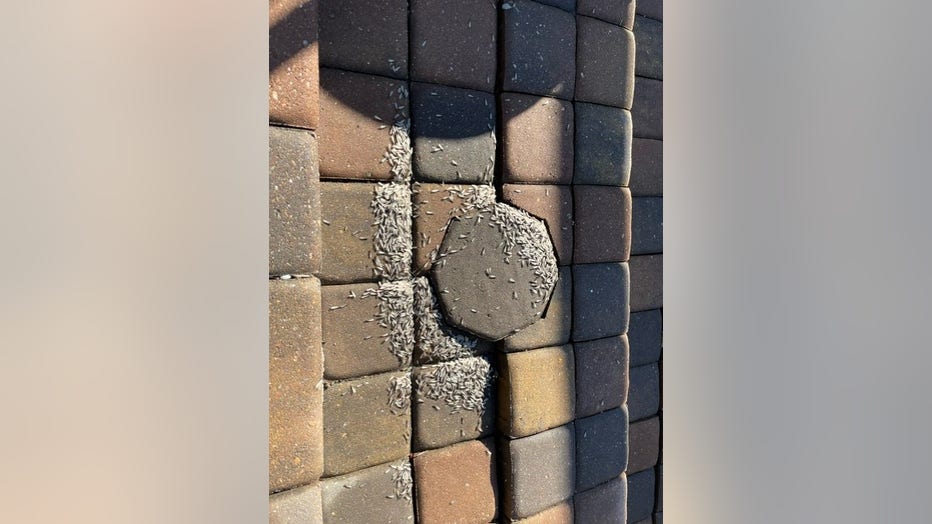What's causing recent swarms of termites in the Bay Area, and when homeowners should worry

Swarms of termites in Bay Area
Many Bay Area residents have been alarmed by recent appearances of termites since the weekend rain. Video from Burge Pest Control shows a swarm in the Oakland Hills on Monday, Oct. 23. 2023.
OAKLAND, Calif. - Many Bay Area residents concerned about their property, have been noticing swarms of termites in recent days that seemed to have suddenly appeared out of nowhere.
The insects have mostly been spotted outdoors, but some were noticed inside homes.
A longtime Bay Area pest control expert identified the bugs as the Western Subterranean Termite, the species most common to this region, and said the insects were doing what they’re genetically inclined to do after the first big rainfall of the season.
"They live in the ground, and they produce swarmers for the specific purpose of swarming," explained owner of Alameda-based Burge Pest Control Rich Crawford, who said he’s been busy fielding calls from worried property owners, following Sunday’s storm.
SEE ALSO: These 21 species have been declared extinct, the U.S. Fish and Wildlife Service says
"The first swarm of the season is the largest," said Crawford, adding, "We’re experiencing a very normal occurrence. The first sunny day after the first rain, every year this happens."

Swarms of termites have been turning up in the Bay Area since the weekend rain. (Burge Pest Control )
The pest expert did speculate there could be an even greater and more noticeable population following last season’s massive rainfall that produced large amounts of ground moisture, which produced the ideal conditions for the termites to thrive.
Residents become keen to the termites when the insects come out from their colonies to find new nesting places.
"Subterranean termites usually give themselves away by accidentally swarming into or off your home," Crawford said. "The other way most people find them is by noticing the tubing they hide in coming from walls, ceilings and cracks," he added.
Crawford explained that despite the images people may have of the bugs devouring all the wood in their homes, the sudden appearance of the insects doesn't always indicate an immediate problem.
"Most properties in this area have Subterranean Termites on it. However, Subterranean Termites have no idea where your home is," he said, adding, "They randomly forage, finding tree stumps and the cellulose in soil and feed on it."
Since Monday, there have been a number of posts on the neighborhood social networking site NextDoor from people who have reported seeing the bugs in or around their property. Many have reached out to those on their feed, asking for help in identifying the critters.
"It is common to find some swarmers without their wings either alone or in pairs. They either landed on the roof and filtered in or literally walked in through the doors," Crawford explained.
He said while Subterranean Termites do cause millions of dollars in damage to homes in the Bay Area every year, a sighting might not be reason for immediate action.
"A couple dozen just walking around does not mean there is an issue," the pest control specialist explained. He also noted that a few bugs inside the home won't create an infestation, as they will dry up and die in a couple of days.
SEE ALSO: Some female frogs play dead to avoid unwanted male advances, study says
However, Crawford warned if dozens of the termites appear in your home with their wings attached or if a large number of their discarded transparent wings are found, that’s when a professional should be called in for an inspection to determine if a colony is attached to a home.
Crawford advised taking these steps to protect your property from termite damage:
- Have your home inspected at least every three to five years as general maintenance against all wood destroying organisms
- Minimize earth to wood contact around your home
- Do not store wood or cardboard boxes against or under your house
Crawford said homeowners should accept the termites’ presence and have an understanding on how to co-exist with the colonies in which the queens are the largest members, with a lifespan of up to 25 years.
"You want to make a deal with the colonies on your property. You ladies can eat my stumps and you can even eat my fence. If you ever touch my home I will kill you all," the expert said, adding, "They have always been on most people's properties and will continue."

